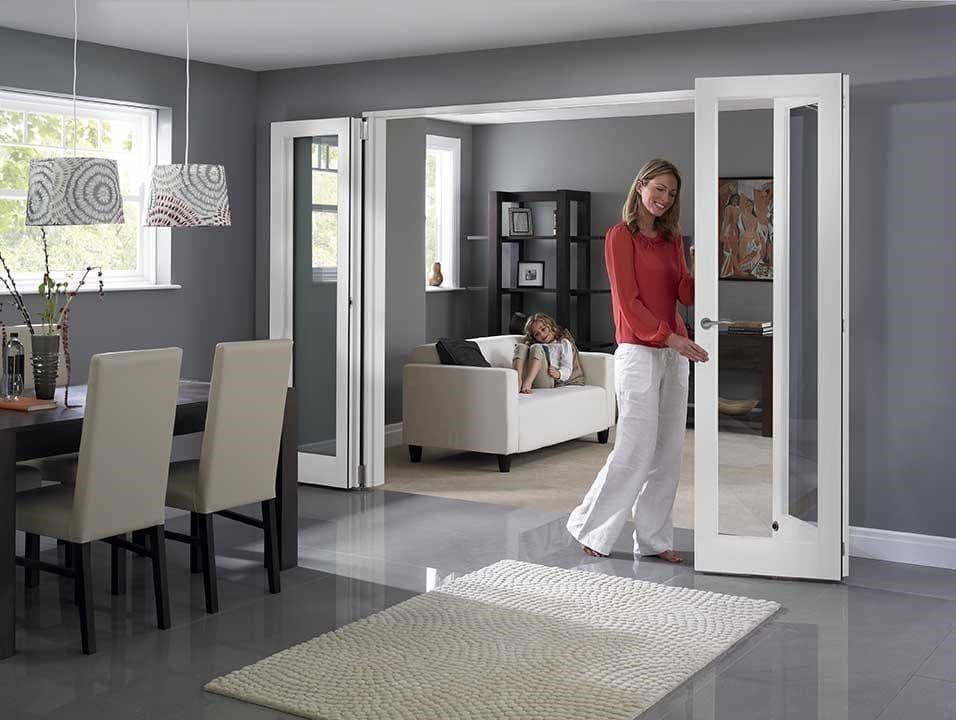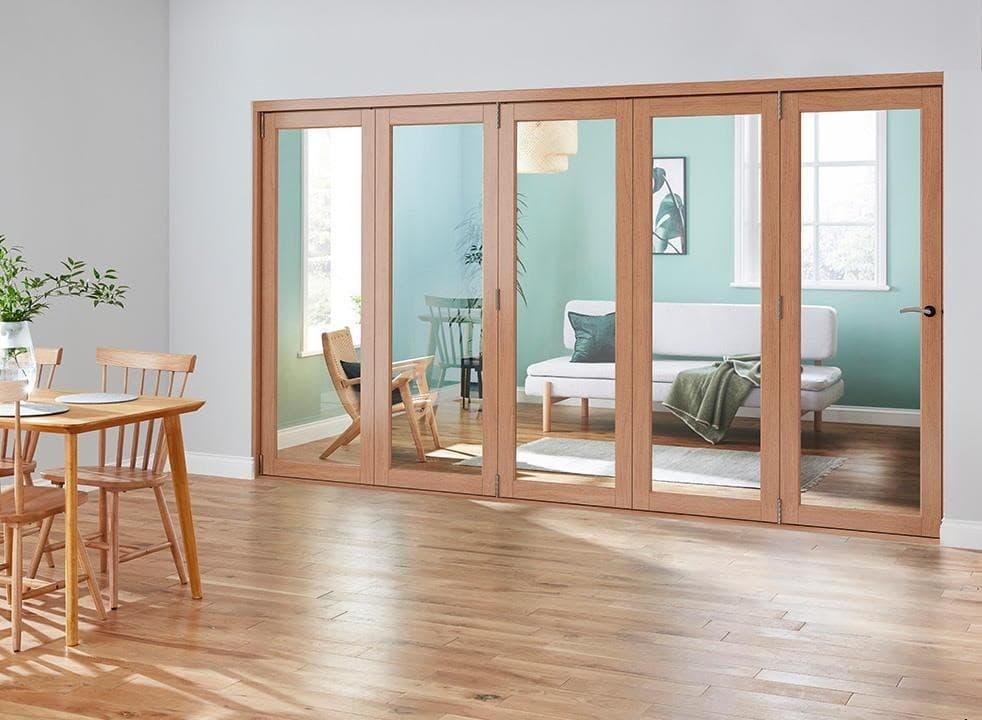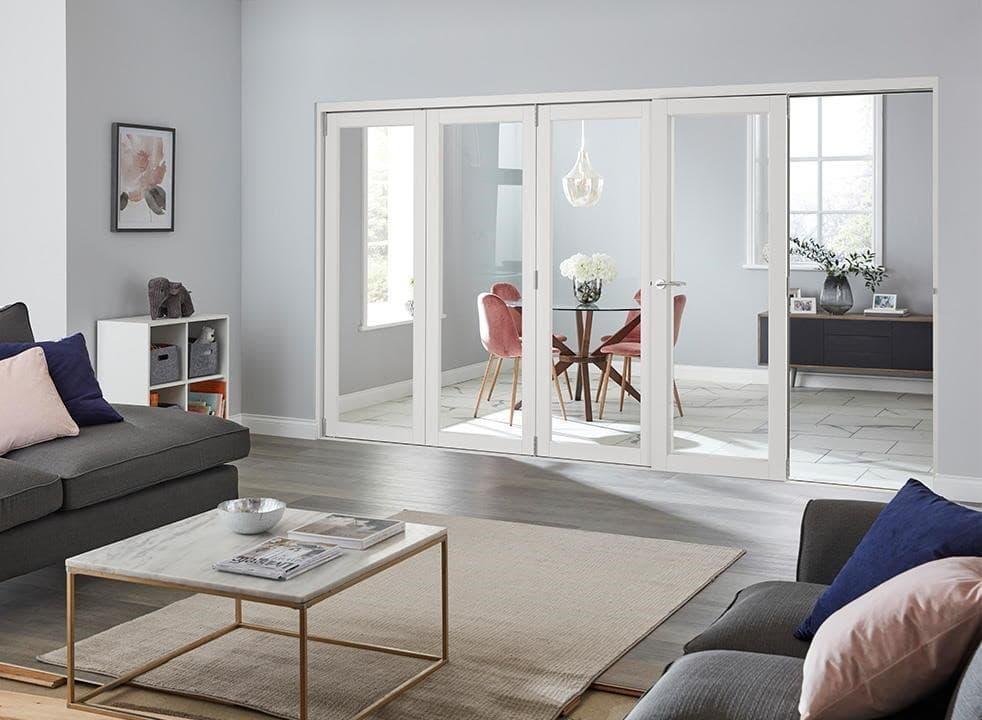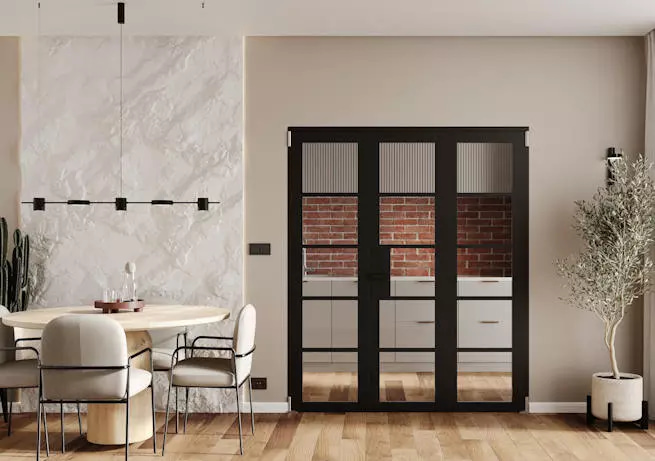A complete guide to buying internal bifold doors | Materials, handles, tracks, finishes and more
Internal bifold doors (also known as concertina doors or internal folding doors) are a great way to introduce more light and space into an interior space. Whether you wish to create a separate space in your home for studying or simply divide your lounge and dining area – internal bifold doors are an eye-catching, modern solution.
If you want to replace an old door, internal bifold doors will provide a flexible solution with a huge range of benefits.
In this guide:
Learn more about the materials available to choose from for internal bifold doors.
Find out more about the benefits of wooden internal bifold doors in this section.
Find out more about white and unfinished oak internal bifold doors.
Learn more about the main types of internal bifold door handles available to you.
This section discusses top-hung and bottom-rolling internal bifold door tracks to help choose the right option for your home.
Read the benefits of choosing Vufold’s internal bifold doors.
WHAT ARE THE MOST COMMON INTERNAL BIFOLD DOOR MATERIALS?
Wooden internal bifold doors are one of the most popular options when it comes to internal bifold doors. Timber doors offer huge range of benefits and allow buyers to choose between many design options. uPVC and aluminium bifold door are traditionally used as external door frame options, however they can sometimes be used internally to match interior décor or to improve space within a room or two rooms. Below provides a brief overview of each material:
|
|
Timber |
uPVC |
Aluminium |
|
Maintenance |
Requires little maintenance |
Requires little maintenance |
Requires little maintenance |
|
Style |
Offers the widest range of style options Can be varnished or painted Options such as unfinished oak provide a rustic and homely aesthetic |
Can sometimes look cheaper than alternatives Some finishes available |
Has a distinct look Aluminium bifold doors come in a large range of powder-coated finishes Lots of design options available |
|
Durability |
Engineered wood offers good durability and no twisting, bowing, or warping |
Fair durability |
Very good durability |
|
Price |
Low to mid-level |
Low-level |
Most expensive |
For a more in-depth look at each door material and their pros/cons, visit our guide: Internal bifold doors: timber vs uPVC vs aluminium.
Are you choosing a new wooden internal bifold door? Read our full guide to wooden internal bifolds.

WHY CHOOSE WOODEN INTERNAL BIFOLD DOORS?
Wooden internal door sets are known for their rustic appearance and inviting aesthetic. However, they are also available in a range of style options and colours, so you are guaranteed to find the perfect option for your home. The following are the main benefits of wooden internal bifold doors:
-
You can choose between a range of styles and designs — wooden bifold doors are available in a range of styles, allowing you to find the perfect option for your home. For example – you may want to choose a steel-look, industrial bifolding door for a more modern feel. Our unfinished oak Finesse doors, on the other hand, can provide more of a traditional feel.
-
Durable and long-lasting — Vufold offers a 15-year guarantee on all interior bifold doors. Engineered wood offers excellent durability and reliability.
-
Environmentally friendly — wooden doors have a simpler manufacturing process compared to synthetic materials, meaning less carbon dioxide. This is ideal if you are conscious about your impact on the environment, and are looking for a greener material.
-
Increased light — using bifolds with glass as a room divider invites more sunlight into both rooms.
-
Sound absorption — wood naturally absorbs sound, which can help reduce noise levels.
Explore our wooden internal bifolds and experience their unique benefits.
WHAT INTERNAL BIFOLD DOOR COLOURS AND FINISHES ARE AVAILABLE?
All of Vufold’s interior folding doors are made from timber. We offer the following finishes and colours:
WHITE INTERNAL BIFOLD DOORS
White is a popular interior décor colour so it’s no surprise that white wooden internal bifold doors are popular too. Choosing this colour will allow you to blend doors in with your current décor. White also goes well with a huge range of interior design colours and styles, and can even help a space to appear larger and brighter.
White bifold doors provide a number of benefits including:
-
Versatile and adaptable
-
Maximise light within a room
-
Ready to hang doors.
Shop our white internal bifold doors here.
To find out more about the best finishes for internal bifold doors, read our guide here: Unfinished oak vs white: best finishes for internal bifold doors.
Read our complete guide to wooden internal bifold doors here.

UNFINISHED OAK INTERNAL BIFOLD DOORS
Unfinished oak doors are delivered to you as unfinished so will need to be treated or finished before you can install the doors. You may wish to retain the wood effect and simply varnish the doors. Alternatively, you might want to paint them a colour that better matches your interior décor. Whichever option you go for, unfinished oak single or French folding doors provide maximum flexibility.
Choose from our Edge, Finesse Frosted, Finesse Clear, or our Inspire range. Shop our full selection of oak internal door options.
To find out more about the differences between pre-finished and unfinished internal oak bifold doors, read our guide here: Internal room dividers: what is the difference between pre-finished and unfinished oak.

BLACK INTERNAL BIFOLD DOORS
Turn heads with a modern, simplistic black internal room divider. At Vufold, we offer eye-catching black internal bifolds to make a classic statement in your home. Our Urban Inspire room divider door sets are an excellent choice for traditional or modern homes, featuring a contemporary 4 light design and one-of-a-kind stainless steel hardware. Shop our range of black internal bifold doors here.
Are you looking for a black internal room divider door to provide seamless transitions between rooms?
Our pick:
URBAN INSPIRE

The Urban Inspire room divider door sets are an excellent choice for traditional or modern homes, featuring a contemporary 4 light design and one-of-a-kind stainless steel hardware. The fold flat design, maximises the opening space. No threshold needed for a seamless transition between rooms.
-
15 Year guarantee.
-
Easy Installation.
-
Features horizontal glazing bars and handle block. Read our guide to choosing internal bifold door handles here.
-
Engineered wood core.
-
4mm thick clear toughened safety glass.
-
Includes a fixing kit and easy to follow instructions.
WHAT ARE THE DIFFERENT TYPES OF INTERNAL BIFOLD DOOR HANDLES?
While handles might be one of the last pieces of door hardware you consider for your bifold doors, they still play an important role in both the overall look of the doors and can have an impact on interior design too. Most internal folding door handles fall into four main categories:
1. LEVER HANDLES
-
Often used on the lead door
-
Common type of handle
-
Simple mechanism.
2. PULL HANDLES
-
Used to pull bifold doors towards you in order to close them
-
Numerous designs but most of them are D-shaped
-
Folds flat against the door so the doors can concertina closely together to take less space.
3. DOOR KNOBS
-
Another common type of handle
-
Available with two types of latches:
-
Tubular mortice latch—similar to a lever handle, except you twist to retract the latch
-
Roller latches (ball catches)—simple pull or push to open and close the door
4. FLUSH HANDLES
-
Used for wardrobes or pantries rather than proper bifold doors
-
Recessed flat or flush into the door
-
Also known as a flat handle
To find out which handle is best for your internal bifold door, visit our guide: Internal bifold door handles: Types, positions and best handles.
WHAT IS THE DIFFERENCE BETWEEN TOP-HUNG VS BOTTOM-ROLLING INTERNAL BIFOLD DOOR TRACKS?
Bifold tracks hold and guide the bifold door rollers, allowing the panels/doors to open and close. They consist of two sections: the main track and the guide track.
When researching bifold tracks, you will encounter two key terms, both relating to where the bifold door’s main track is located:
-
Top-hung (located in the frame head)
-
Bottom-rolling (bottom threshold of the frame).
You may also see references to ‘trackless systems’. A trackless system has no base track running across the floor of your room and can only be used with top-hung bifolds.
|
|
Top-hung |
Bottom-rolling |
|
Pros |
Smooth operation—top weight means less force is required to move along the track Low-maintenance—highly unlikely that debris will collect in the upper track, so less maintenance is required Lower threshold—the guide track is based at the bottom, which has a slimmer profile than the upper main track |
Requires slightly less support—bottom-rolling systems have their weight carried on the floor Installation—fewer holes are needed in the guide track that is located in the frame head Secure doors—doors cannot fall out of top-hung tracks |
| Cons |
Installation—the main track of bifolds must be securely fastened over the full length of the door set—this requires drilling holes upwards, which can be awkward |
Blockages—debris and small items can jam the main track at the lower part of the door set Maintenance—to stop blockages, you will regularly need to clean the bottom track Track dipping—if the main bottom track isn’t perfectly level, the track can dip. This can disrupt operation and cause the doors to fall out of the guide track Higher threshold—bottom-rolling systems have a higher threshold at the bottom of the door step. This is a trip hazard and is much harder to install flush. |
To find out more about internal bifold door tracks, including FAQs, visit our guide: Internal bifold door tracks: types, hardware & FAQs.
Frequently asked questions
What are the benefits of using internal bifold doors?
-
Space-saving: They require less floor space than standard doors because they fold rather than swing open.
-
Flexibility: They allow for flexible management of space, as they can be fully or partially opened or closed.
-
Aesthetic appeal: Available in various designs and finishes, they can enhance the interior decor of a home.
-
Increased natural light: When installed with glass panels, they allow for an abundance of natural light to flow between rooms.
Can internal bifold doors be customised?
Yes, many bespoke bifold door manufacturers offer custom sizes and finishes to fit specific openings and match interior design themes. Bespoke internal bifold door options may include different types of glass, panel configurations, and frame materials.
How much do internal bifold doors cost?
The cost can vary widely based on the material, size, and customization options. Generally, wooden doors tend to be more expensive than those made of uPVC but are often cheaper than aluminium options. Additional features like thermal insulation or specialised glass can also affect the price.
What maintenance do internal bifolds require?
Maintenance generally involves regular cleaning and periodic checks of the track system and hinges to ensure smooth operation. Lubricating the tracks and hinges can help prevent wear and tear.
Contact us today
Vufold’s range of internal bifold doors have been manufactured to be easy to adjust to make sure your doors operate properly and effectively to minimise damage. Offering 15-year guarantees and a huge range of door furniture and hardware – you can enjoy the best-quality internal bifold doors in the market. Our internal bifold doors are also available in both clear glass and frosted glass.
You can find out more about our internal bifold doors here.
At Vufold, our team of experts is always available to provide you with advice and guidance on everything to do with our range of internal bifold doors, hardware, and accessories. Please contact us to find out more technical information or to discuss your needs.
RELATED CONTENT

About Amanda Hewer
Having been at Vufold for around 12 years now, Amanda became operations manager after spending time in Customer Service, Sales, Order Processing and our Warehouse. Amanda likes that no two days are ever the same and believes her successful career stems from her keen interest in people, helping them achieve their goals and striving for constant improvement across all departments.
Read more about Amanda Hewer



